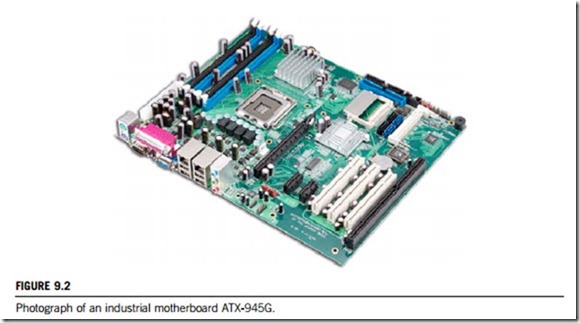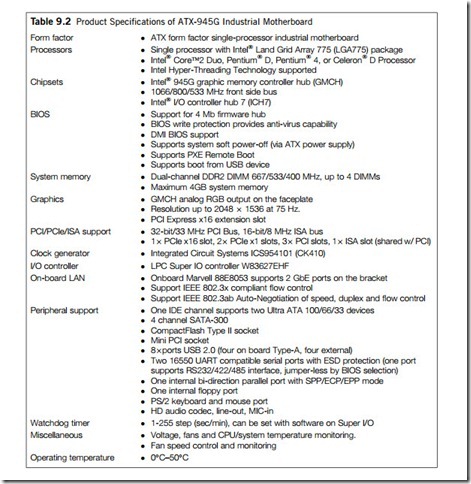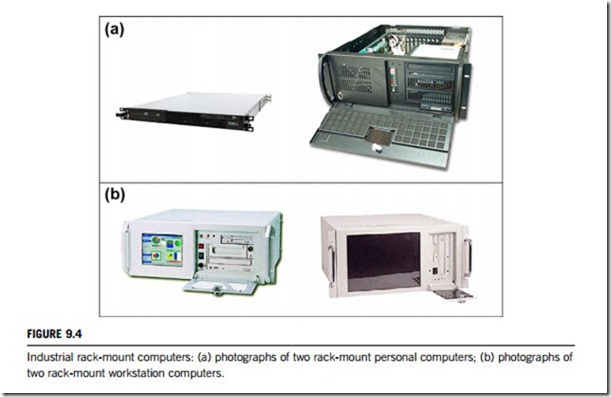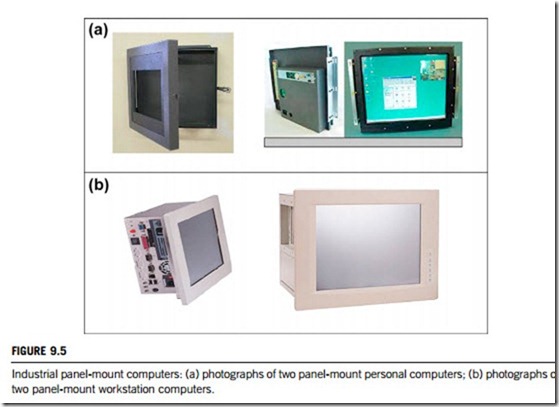INDUSTRIAL COMPUTER CLASSES AND CONFIGURATIONS
Industrial computers are available in several classes and configurations with a variety of CPUs, displays, I/O interfaces and enclosures. They can be industrial motherboards, industrial single-board computers, industrial embedded computers, and industrial personal computers and workstations. Choices for configuration or mounting style include desktop, portable or notebook, panel or rack. Desktop computers are enclosed for desktop applications. Classes, configurations, mounting style, processor type, processing speed, resistance to harsh conditions, memory, storage, and display are the most important parameters to consider when looking for industrial computers. Additional specifications include I/O interfaces, expansion slots, power supplies, features, environmental parameters and so on.
9.1.1 Industrial computer classes
Industrial computers can be industrial motherboards, industrial single-board computers, industrial embedded computers, industrial personal computers, and workstation computers.
(1) Industrial motherboards
Motherboards are the foundation of all computers. They are printed-circuit boards (housing the computer’s basic circuitry and vital components), into which other boards, or cards, are plugged. They manage all data transactions between the CPU (central processing unit) and the peripheral devices. Their main components are memory, CPU, microprocessor and coprocessors, BIOS, interconnecting circuitry, controllers, mass storage, parallel and serial ports, and expansion slots. Other component devices and peripherals can be added through expansion slots, including the monitor screen, the keyboard, disk drives, etc.
There are two important differences between industrial and standard motherboards. Firstly, industrial motherboards need to be more rugged than standard models. Since they are used in tougher conditions than standard computer motherboards, industrial motherboards, like industrial LCD displays or industrial LCD touch screens, need to be able to cope with higher temperatures and need to be tougher in case of a shock or a hit. Secondly they need to be able to easily handle the massive amounts of information which are essential to industrial operations and controls. They are used also for many critical functions and applications, such as industrial control, the military, aerospace industries, and the medical field.
The interface between computer motherboards and smaller boards or cards in the expansion slots is called the bus. Industrial motherboards communicate with and control peripheral devices via buses or other communication standards. Some of the most common buses are ISA (Industrial Standard Architecture), ESA (Extended Industrial Standard Architecture), and PCI (Peripheral Component Interconnect).
As an illustration, Figure 9.2 is a photograph of the ATX-945G Industrial ATX motherboard by Quanmax Corporation; Figure 9.3 is the system block diagram of the ATX-945G Industrial ATX motherboard. Table 9.2 gives its product specifications.
(2) Industrial single-board computers
A single-board computer has one circuit board that contains all the components (i.e. processor, memory, I/O, drive, bus, interface, etc.) necessary to function as a complete digital computer. In other words, single-board computers are those, and which are completely built on a single circuit board are composed of a microprocessor, memory chip, and serial and parallel interfaces to communicate with other devices. Processor or CPU type, processor speed, I/O bus specifications, memory, I/O interfaces, and storage types and volumes are important specifications to consider when looking for single-board computers, along with chipset type, features and environmental parameters.
Because of the very high levels of integration, reduced component counts and reduced connector counts, single-board computers are often smaller, lighter, more power-efficient and more reliable than comparable multiple-board computers. They are found in many applications we use, such as laptops
and notebooks, or serve as the motherboard for instrumentation systems. Single-board computers are most commonly used in industrial situations. They are designed to be integrated with other electronic components to form an industrial machine for process control; or embedded within other devices to provide control and interfacing.
Single-board computers are now commonly defined across two distinct architectures: no slots and slot support. The term single-board computer now generally applies to an architecture where it is plugged into a backplane to provide for I/O cards. The most common variety in use is similar to other full-size plug-in cards and is intended to be used in a backplane. In Intel personal computers, the intelligence and interface/control circuitry is placed on a plug-in board that is then inserted into a passive or active backplane. The end result is similar to having a system built with a motherboard, except that the backplane determines slot configuration.
Embedded single-board computers are boards providing all the required I/O with no provision for plug-in cards. Applications are typically gaming (slot machines, video poker) and machine control. They are much smaller than motherboards, and provide an I/O mix which is more targeted to an industrial application such as on-board digital and analog I/O, on-board bootable flash so no hard drive is required, no on-board video, etc.
The development of personal computers brought a sharp shift away from single-board computers, with construction comprising a motherboard, with functions such as serial ports, disk drive controller and graphics provided on daughterboards. The recent availability of advanced chip sets providing most I/O features as embedded components allows motherboard manufacturers to offer motherboards I/O that also have the traditionally provided by daughterboards. Most that was now offer on-board support for disk drives, graphics, Ethernet, and traditional I/O such as serial and parallel ports, USB (universal serial bus), and keyboard/mouse support. Plug-in cards are now more commonly used for high- performance graphics cards (really graphic co-processors), and specialized uses such as data acqui- sition and DSP (digital signal processor) boards.
(3) Industrial embedded computers
Embedded computers are all-in-one devices used to handle special-purpose computing tasks for business and industrial applications. Industrial embedded computers, or embedded industrial computers, are those that are incorporated into some system or device that do not inherently require these computers for basic operations. Thus embedded computers are mostly used to improve and expand production processes or operation controls.
Consider the changes that have taken place in automotive electronics: not only are embedded computers being incorporated into very visible devices such as navigation systems, they are also being used for fundamental functions of cars in devices such as braking systems. All devices, from phones to cars, that contain embedded computers create opportunities for the supply of both hardware and software. Although most is specialized for embedded use, much is also common to both computers and embedded computers. This means that demand for embedded computers of various types has further repercussions on demand for everything from semiconductors to software to services.
From this point of view, most industrial computers are assumed to be embedded computers, since they are incorporated into larger industrial systems or devices to fulfill their assigned functionalities. The following are the main types of embedded industrial computer used in industrial controls, production and management.
(a) Embedded single-board computers
Embedded single-board computers are highly integrated embedded computers that build immediate trust by guaranteeing standard form factors that speed development times, increase flexibility, provide for future expansion, and offer scalable performance and advanced features to fill a wide variety of applications. With a strong product strategy, excellent product development and management, flexible global manufacturing capability and leading technology, reliability is built into every embedded single-board computer!
(b) Vertical purpose embedded computers
Some industrial computer manufacturers offer a series of durable and application-ready embedded computer boxes for a range of applications, such as automation, control, transportation, entertainment, surveillance, servers etc. Vertical purpose embedded computers are all-in-one embedded systems with strong mechanical design and excellent anti-shock and anti-vibration properties and thus can be extremely reliable in a harsh environment.
(c) Ruggedized embedded system with expansions
To fulfill customers’ diverse needs, there exist a series of outstanding expandable embedded computer systems featuring various types of expansion slots, such as AGP, PCI, PCIexpress, ISA, ESA etc. The user can easily plug in graphic cards, motion cards, or communication cards for system expansion and system integration.
(d) Cost-effective embedded system
Some industrial computer manufacturers provide high-performance yet cost-effective solutions to get to market easily and quickly. The cost-effective embedded systems furnish customers with all their needs such as powerful computing capability, fanless operation, low power use, reliability, flexible I/O configuration, and long product life support.
(e) Industrial barebones system
A full range of rack-mount systems with industrial motherboards such as the ATX / Micro ATX motherboards allow companies to setup barebones applications. Industrial rack-mount barebones deliver powerful computing performance, expansibility, high storage capacity, reliability and cost- effectiveness, and feature solid designs. Also available as complete certified systems, this industrial computer series provides the most popular interfaces, such as Ethernet ports, USB ports, PCI expansion slots, PS/2 ports, and COM ports.
(4) Industrial personal computers and workstation computers
Industrial personal computers, like other kinds of industrial computers, are rugged industrial-grade, models for use in harsh environments. They are available in many types and configurations with a variety of CPUs, displays, memory, I/O interfaces and various mountings. Their most important parameters are: configuration or mounting style, processor type, memory, storage, and display. Additional specifications include I/O interfaces, slots, expansion cards, power supply, features, and environmental parameters.
Industrial workstation computers, like their office counterparts, are used as client/server computers that connect to an industrial network to share data with other machines. They are used in applications such as computer-controlled manufacturing, computer-aided automation, database data entry, graph displaying, and product imaging. In terms of computing power, low-end workstations are equivalent to high-end personal computers while high-end workstations are equivalent to minicomputers.
Computer workstations vary widely in terms of slots and expansion bays. Some use industry standard architecture (ISA) while others use peripheral component interconnect (PCI) technology. Input/output (I/O) ports can be serial, parallel, wireless, or networked. Universal serial bus (USB) is the standard serial bus for low- to medium-speed peripheral devices. Network protocols include Ethernet and Token Ring. Some computer workstations incorporate wireless local area network (WLAN) technology.
Computer workstations are available with a variety of operating systems and processors. They provide random access memory (RAM) with separate internal and external caches and may even include Flash memory, a type of RAM that can retain information when the computer is powered off.
Computer workstations feature a variety of display, resolution, and user interface options. Cathode- ray tube devices use an electron beam to illuminate phosphor dots and are suitable for users who require relatively high screen resolutions. Flat panel displays, which are often very thin, are used with portable or laptop computers and include technologies such as liquid crystal display and gas plasma. Computer workstations are also available with color or backlit displays, membrane or tactile keyboard interfaces, and voice or handwriting recognition capabilities.
Both industrial personal computers and industrial workstation computers are mostly rack, panel, or wall mounted. These configurations are introduced in the next subsection.
Industrial computer configurations
Computers are configured by equipping them with different computer chassis, mounts, monitors, etc.
(1) Industrial rack-mount computers
Rack-mounted computers are widely used by manufacturing facilities and laboratories. This configuration provides reliability, ease of maintenance and stability. They featured a variety of processor and bus configurations and many supports such as PCI and ISA busses, side-access serial ports, parallel ports, USB port, external monitor port, I/O link, and an Ethernet port, removable hard drive and power supply, along with front-accessible USB and so on. In addition, rack-mounted computers support various embedded operating systems including Windows and embedded Linux. Figure 9.4 shows two groups of photographs for both rack-mounted personal computers and workstations.
(2) Industrial panel-mount computers
Industrial panel computers are a space-saving solution for areas where multiple operators use a single computer. This configuration is cost-effective, highly reliable, and a powerful performance product designed to operate in harsh environments. They featured a variety of processor and bus configurations and many supports such as PCI and ISA busses, side-access serial ports, parallel ports, USB port, external monitor port, I/O link, and an Ethernet port, removable hard drive and power supply, along with front- accessible USB and so on. In addition, panel-mount computers support various embedded operating systems including Windows and embedded Linux. Figure 9.5 shows two groups of photographs for both panel-mount personal computers and panel-mount workstation computers.
(3) Industrial wall-mount computers
There are a number of reasons a computer screen may be required to be fixed to the wall. It could be a space-saving effort, or it could be required for such information as promotional material and company data to be screened within an office or shop environment. A specific type of wall mount is needed depending on the size of the computer display, and the height at which it is to be mounted.
There are two models of wall-mount computers: a basic but more customizable wall-mountable computer station, and a motorized unit that offers less customization. Wall-mount computers attach to a wall via plates that are bolted directly into a secure area of the wall, making an extremely strong attachment. Figure 9.6 shows two groups of photographs for both wall-mount personal and work- station computers.




